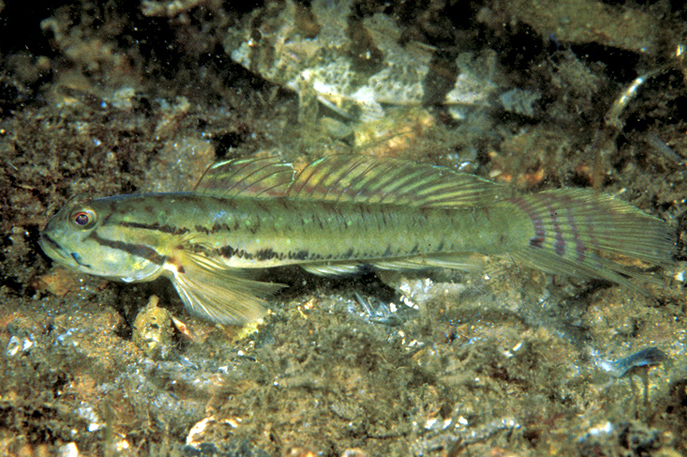- Classification
- ACTINOPTERYGII
- PERCIFORMES
- GOBIIDAE
- Arenigobius
- bifrenatus
Bridled Goby, Arenigobius bifrenatus (Kner 1865)

A male Bridled Goby, Arenigobius bifrenatus. Source: Rudie H. Kuiter / Aquatic Photographics. License: All rights reserved
A medium-sized goby with two oblique dark bands originating on the head. The upper band crosses the gill cover and runs horizontally along the midsides, to at least below the first dorsal fin. The lower band runs from below the eye, through the pectoral fin base to the lower sides, breaking up into diffuse purplish-brown spots above the anal fin. Males have an elongate caudal fin.
Bridled goby pairs live in burrows on sandy, silty or muddy bottoms in the upper reaches of bays and estuaries.
Bridled Goby, Arenigobius bifrenatus (Kner 1865)
More Info
|
Distribution |
Endemic and widespread in southern Australia from Moreton Bay (Queensland) to the Perth region (Western Australia), and around Tasmania. The Bridled Goby inhabits burrows in the muddy areas of shallow bays and estuaries in 0-10 m. In 1998, Arenigobius bifrenatus was discovered to have invaded New Zealand. The species is now well established in estuaries around eastern Northland and Auckland. It is thought to have been introduced with ballast water from passing ships (Willis et al. 1999; Francis et al. 2003). |
|
Features |
Dorsal fin VI, I, 10; Anal fin I, 10; Caudal fin (segmented rays) 17; Pectoral fin 16-18; Pelvic fin I, 5. |
|
Size |
To 18 cm |
|
Colour |
Overall greyish to pale olive-brown with iridescent pale blue spots along sides; two oblique dark bands originating on head below eye, upper breaking up into diffuse purplish-brown spots running from pectoral-fin base to lower sides above anal fin. |
|
Feeding |
Feeds on benthic invertebrates. |
|
Biology |
The sexes are separate and females spawn demersal eggs in burrows. |
|
Remarks |
Juveniles are similar to those of Arenigobius frenatus. They are similar in colour, and the caudal fin is short and rounded in both species. It is sometimes necessary to count scales to separate small individuals. |
|
Similar Species |
Differs from Arenigobius frenatus in lacking dark spots on top of the head, having the dark stripe from the pectoral fin base running along the lower surface of the body and breaking up into a series of irregular spots, and an elongate caudal fin in adults. |
|
Etymology |
|
|
Species Citation |
Gobius bifrenatus Kner, 1865, Reise 'Novara', Zool. 1(5): 177, fig. 3 Type locality: Sydney, New South Wales. |
|
Author |
Bray, D.J. 2017 |
|
Resources |








